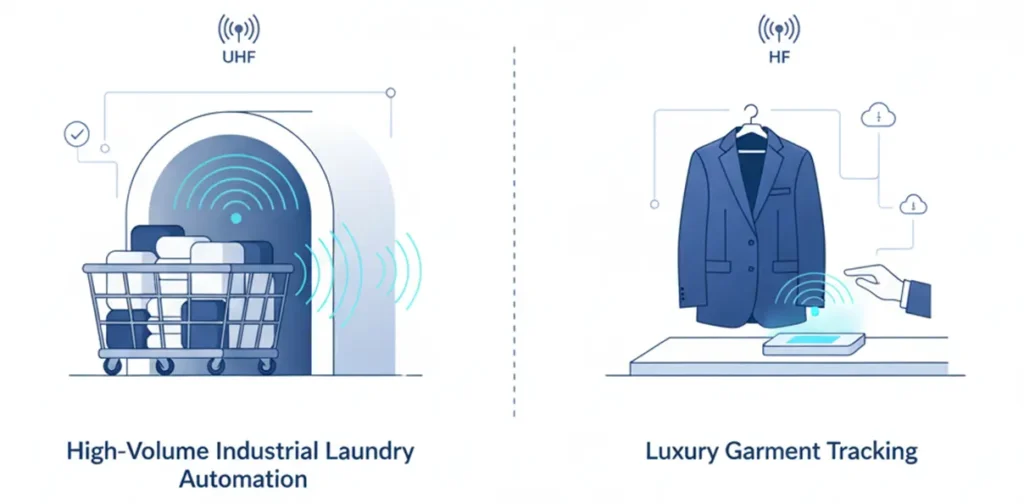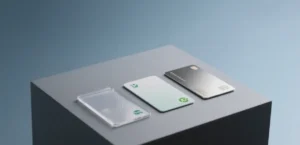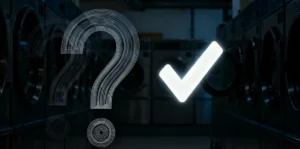
UHF vs. HF: Which RFID Frequency Fits Your Laundry Business?
Custom Your RFID Cards
Which RFID Technology Fits Your Laundry Business? Should you choose UHF or HF? It’s not a technical choice, it’s a business decision.
The wrong RFID frequency often leads to failed laundry automation projects. This guide explains how to choose RFID laundry tags based on your operation, total cost, and long-term performance.
UHF: The Business of Efficiency and Scale
1.1 What kind of business are you running?
If you run an industrial laundry, linen-rental service, or hospital laundry, your profit depends on throughput. Labor is your main cost, and time is your main limit — how many pieces your team can process each hour.
Every manual scan or sort adds seconds and reduces your margin.
1.2 How UHF fits this model
UHF tags are built for speed and range. They can be read hundreds of items per second from several meters away. In large-scale laundries, this enables automatic, hands-free scanning.
A common setup is an RFID tunnel or gate reader.
Laundry carts move through while the system records every tagged item instantly — no stopping, no manual check.
The result is continuous data capture that turns manual handling into a steady production line.
UHF also supports process visibility. Managers can track items in real time across receiving, washing, and dispatch, improving accuracy and cutting labor time.
1.3 The real cost of UHF: Your total cost of ownership
Let’s break down the major cost layers for a typical UHF deployment:
| Category | Description | Typical Cost (USD) |
|---|---|---|
| Tags | Bulk passive tags optimized for long-range reading | $0.10–$0.25 each |
| Gate/tunnel readers | Multi-antenna units with controller and setup | $3,000–$8,000 per set |
| Handheld readers | Industrial-grade Android or Windows units | $400–$1,200 each |
| Middleware & integration | Platform linking readers, ERP, and reporting tools | $5,000–$20,000 per project |
While the upfront cost is notable, the returns come from reduced labor and faster throughput.
A UHF system can read thousands of items per hour with minimal human effort — cutting handling time, improving accuracy, and delivering full traceability.
In laundries where time is the main cost driver, UHF shifts tracking from manual scans to continuous automated flow.
1.4 What comes next
If your business model clearly points to UHF, your next step is to choose the right tag materials for durability and wash resistance.
👉 Read: PPS vs. Textile vs. Silicone — Choosing the Best RFID Laundry Tag Material.
HF: The Business of Precision and Value
2.1 What kind of business are you running?
If you run a premium dry-cleaning chain, garment-care service, or hotel valet, your value comes from precision and customer trust, not volume.
Your key risk isn’t labor, it’s mistakes. Losing or mislabeling a $1,000 suit costs more than spending a few extra seconds verifying it.
2.2 How HF fits this model
HF tags work at short range (0–10 cm) and only be read one item at a time. That slower pace is intentional, it ensures verification at each step.
Typical setup: a desktop or handheld reader.
At the counter or pressing station, staff tap the garment tag once — one beep, 100% correct ID.
No cross-reads, no mix-ups, no disputes.
2.3 The real cost of HF: Your total cost of ownership
| Category | Description | Typical Cost (USD) |
|---|---|---|
| Tags | Slightly higher unit price due to embedded chip and encapsulation | $0.25 – $0.40 each |
| Desktop readers | USB or Ethernet-connected readers for check-in/out | $150 – $500 each |
| Software integration | Light middleware or POS interface | $1,000 – $5,000 range |
HF systems need minimal infrastructure. There are no gate readers, no antenna calibration, and no RF tuning. Deployment can start with a few desktop readers and a simple management module.
The ROI comes from accuracy, not scale.
Zero read errors mean no compensation, no rework, and no customer disputes. It is a direct protection of margin and reputation.
The Decision Tree: Find Your Perfect Fit
Still not sure? Start with two quick questions.
Question 1: How many items do you process each day?
Thousands per day (by the ton) → UHF
Your main constraint is efficiency. Automation saves time and labor.
Dozens or a few hundred items → HF
Your main constraint is precision. Reliability and customer trust matter more.
Question 2: What’s your biggest risk?
Paying wages for ten workers manually sorting linens all day → UHF
Replacing a customer’s lost designer suit → HF
Lessons from the Field
When clients ask us to quote RFID laundry tags, the first question is always the same: “Which frequency is better?”
After dozens of implementations across laundries, hospitals, and hospitality operations, we’ve found that “better” is always about context.
Performance depends on business model, workflow design, and system scale, not the tag type alone. Here are three key insights drawn from real deployments.
1. Success depends on system design, not tag price.
A low-cost tag on a poorly tuned system is still expensive. Unread tags create manual rework and destroy ROI.
Focus on reader placement, antenna tuning, and process flow, these define accuracy and throughput far more than per-tag pricing.
2. Environment compatibility drives ROI.
Metal shelving, moisture, and dense textiles affect signal propagation. In industrial laundries, using anti-metal tags and properly shielded gates is not optional — it’s essential for stable read rates. Skipping this to save on hardware almost always leads to project failure.
Metal racks, moisture, and textile density all affect signal behavior. In industrial laundries, use anti-metal tags and shielded reading zones. Cutting corners on hardware calibration almost always leads to unstable reads and failed automation.
3. RFID delivers value beyond counting.
When integrated with your ERP, with the right setup, you can track each garment from check-in to dispatch. The result is a data-driven operation: traceable assets, fewer disputes, faster billing, and better capacity planning.
Conclusion: Match the Technology to Your Business
There’s no “best” frequency — only the right fit for your business model.
- UHF enables scale: high-volume operations where every second counts.
- HF ensures precision: value-driven operations where every item counts.
Success comes from understanding total cost of ownership — hardware, software, and process alignment.
That’s what separates sustainable RFID strategies from costly trials.
When the technology fits the workflow, RFID doesn’t just track laundry — it transforms operations into measurable performance.
Further reading:
- FAQ: Common Concerns When Buying RFID Laundry Tags
- Or Contact us for a free consultation


